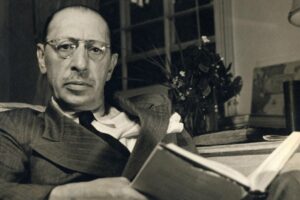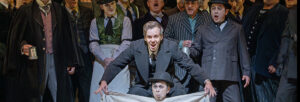
Janai Brugger “offered an honorable interpretation in the lyric soprano tradition.”
When the Philadelphia Orchestra announced a digital concert of Mahler’s Symphony No. 4 in G Major, I initially shrugged. Not because I dislike the work—on the contrary, it’s one of my favorites in the standard repertory. But it’s become increasingly familiar programming since Yannick Nézet-Séguin became music director in 2012.
Nézet-Séguin has led the symphony twice himself, both at the group’s Broad Street venue, Verizon Hall, and its summer home in Saratoga Springs, New York. It also served as the showpiece for Mirga Grazynite-Tyla’s promising debut with the Philadelphians just two years ago. Soprano Janai Brugger, who returned for the streaming concert, sang the fourth-movement solo “Das Himmlische Leben” in those performances. All in all, Mahler’s ethereal evocation of the natural world, and the world beyond our own, is becoming old hat.
Mahler has been a focus of Nézet-Séguin’s tenure in Philadelphia—the first piece he led the orchestra in was Mahler 5, and last year, he conducted a performance of Symphony No. 9 that rivalled any European ensemble in richness of sound and interpretive depth. But there’s still much that hasn’t yet been explored. Why not program Das Lied von der Erde in the chamber variation by Schoenberg and Riehn? Or Des Knaben Wunderhorn?
Perhaps I was cranky going into the concert, which also featured the first local performance of Starburst, a short string ensemble by the rising composer Jessie Montgomery. But my cynicism melted away when I remembered a few things. First, Mahler’s music is a joy in and of itself, and the best musicians bring new insight to even the most well-known works.
More to the point, there is no way the orchestra, given current coronavirus restrictions on size of gatherings and length of performances, could present a Mahler 4 as we are accustomed to it. The ensemble employed the rarely heard adaptation that Erwin Stein conceived for Schoenberg’s Society for Private Musical Performance.
The reduction of musicians and reliance on piano and organ to fill out the symphony’s sound world resulted in leaner textures and a brisk overall performance, with crisp transitions between movements. For an orchestra long known and prized for its uniformity, it also allowed special attention to be paid to the many solo voices within the piece.
Individually and in combination, flautist Jeffrey Khaner (doubling on piccolo), clarinetist Sam Caviezel and newly arrived principal oboe Philippe Tondre gave voice to many natural elements, from the rustling of wind to the movement of clouds. Concertmaster David Kim performed the violin solo lines with a homey intimacy. Organ virtuoso Paul Jacobs, who often appears with the Philadelphians as a soloist in the major concertos for his instrument, instead blended beautifully as a guest ensemblist.
The job of pulling the narrative together fell to pianist Kiyoko Takeuti. She crafted a sense of musical continuity that compensated for the reduced instrumentation, and the individual tone of her playing was distinctive without being overwhelming. Fellow keyboardist Davyd Booth provided rhythmic support from a second piano placed farther back on the Verizon Hall stage.
When Brugger performed “Das Himmlische Leben” under Grazinyte-Tyla’s baton, she made little impression on me. Of course, those concerts came the week after the Eagles won the Super Bowl, and the orchestra cancelled some performances in the run so as not to interfere with the expectedly rowdy celebrations in Center City. (Foisted by the straights again!) My main memory was that Brugger’s modest sound didn’t carry well in the house, and that the absence of a lieder singer’s text-focused interpretation was keenly felt.
Brugger’s German was not any more distinguished this time around, but she sang with an expansive, velvety tone that no doubt benefitted from not having to push for projection. She also seemed to connect more with the air of childlike wonder than she did two years ago. In a piece that’s been taken up by everyone from boy sopranos to blowsy mezzos, she offered an honorable interpretation in the lyric soprano tradition.
While the Mahler can last anywhere from forty to seventy-five minutes, depending on the conductor—Nézet-Séguin’s was about an hour—Montgomery’s Starburst barely occupied five. Most pieces I’ve heard from this composer have been similarly short, which is a shame, because they always leave me wanting more. Here, she manages to cram the entire string experience into the attenuated time frame, creating a composition that is equally ecstatic and unsettling. If Mahler represented the tranquility of nature, Montgomery shows us the volatility.
As a living artist, a woman and a person of color, Montgomery represents the future of classical music the orchestra was finally beginning to acknowledge when the pandemic shut down in-person concerts back in March. I’m glad to see them continue their mandate to diversify the repertoire on the digital stage, and I hope it continues when they can welcome audiences back to the Kimmel Center. That will truly be the heavenly life.
Photo: Dario Acosta











Comments